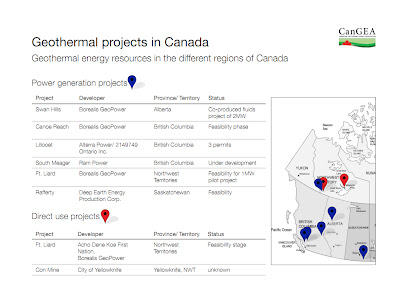When we consider possible renewable energy sources, we often
think of those that are non-invasive and that we may see or hear about on daily
basis, such as solar, wind and hydroelectricity. But what about other ways,
ones that may be invasive but are right under our noses (or feet) – Geothermal
Energy.
According
to William E. Glassey, “geothermal energy (GE) is remnant heat derived from the
formation of the planet four and a half billion years ago, as well as heat from
radioactive decay of naturally occurring unstable isotopes”. It is both directly and indirectly from
heating homes and buildings to generating power for green houses or agricultural
use, either way; it is virtually an inexhaustible energy source. (Glassey,
2010). You may wonder what makes it so superior to other sources of renewable energy.
In fact, there is already enough heat in
the subsurface of the earth to satisfy the energy needs of every nation of the
world many times over, making it real alternative to non- renewable energy.
Geothermal power is divided into 3
groups: geothermal energy for power generation, direct use and geo exchange.
Power generation and direct use utilize the heat and energy that is transmitted
from the earth or radioactive decay; where as geothermal heat pump applications
acquire heat from the sun. (Canadian Geothermal Projects Overview 2012). If
non-renewable, carbon procucing energy sources were replaced by geothermal resources;
we could decrease the carbon emissions by a minimum of 90% and up to 100%
(Glassey, 2010)
Even as
an oil producing nation, our non-renewable resources are quickly becoming diminished
and our environment is being harmed. So where does GE come in? GE requires no
fuel and has an output of very few emissions. As oil and gas prices continue to
soar, GE is and remains a good option for Canadians. In fact, the implication
of GE may help Canada tackle some of its greatest challenges, including:
climate change, job opportunities and energy security. In fact, the opportunity
for geothermal energy is immense, currently 5,000 MW in shallow geothermal
resources, which could create more than 10,000 full and part time jobs! As
technology continues to develop, the opportunity to use deep geothermal
resources also increases with an available 10,000 MW in energy.
Figure 1: Geothermal opportunities in Canada ; http://www.cangea.ca/images/uploads/120202_Canada_GeothermalProjectOverview.pdf
There
are currently multiple geothermal projects in place, within Canada, usually
favoring the western side of the nation. The Swan Hills Project located in the
Swan Hills of Alberta, is a cooperative effort between the Borealis Geopower,
Free Energy, Devon (Canada) and the Alberta Government. (Canadian Geothermal
Projects Overview 2012). The goal of this project is to research the possible
utilization of geothermal energy as well as generate electric power. This
project is considered a ‘pilot’ project in looking at the possible viability of
geothermal energy in Canada and the possible used of abandoned oil and gas
wells to produce geothermal energy. The use of GE is also very beneficial to
northern and isolated communities. The input of small geothermal plants may
reduce or diminish the need for fuel import completely, and thus allowing such
areas to become a little more independent.
Figure 2: Current geothermal projects in Canada
Even
though a lot of the available geothermal energy cannot be utilized because the
lack of technology developed, it remains a good option for Canada to reduce the
amount of green house gases entering the atmosphere and could be an opportunity
to not only improving our environment but our economy as well.
References
Glassley, W. E. (2010). Geothermal Energy: Renewable Energy and the Environment. Florida: Taylor and Francis Group.


Very interesting post - geothermal definitely seems like an interesting one to add to our portfolio of energy options.
ReplyDeleteI attended "The Future We Want" panel discussion on sustainable development this past Sunday and one of the speakers, David Bazeley, Former Director of Energy Policy (NL Government) referred to geothermal in his talk on "Our Energy Future". He wasn't very encouraging however, saying that there was no real generation potential for it here in Newfoundland. Why would that be? I note the references you have also seem to focus on Western Canadian examples.
When I went to college, my campus was heated by geothermal energy (we also had a constructed wetland which filtered the grey water, and a wind turbine). Many "green" energies have downfalls. For instance, wind turbines can be a eyesore and can impact bird populations, hydro power floods areas and destroys habitat, solar energy is not very reliable and expensive. What are some of the downfalls of GE?
ReplyDeleteMike and Nike
How much does it cost for a homeowner in NFLD to put in geothermal to their house?
ReplyDeleteJust out of curiosity why do the geothermal projects favor the western part of the nation more than the eastern?
ReplyDeletethank you
Useful Information, your blog is sharing unique information....
ReplyDeleteThanks for sharing!!!
uses of geothermal heat energy for agriculture
agricultural distribution center
agricultural account management software